While there are not a lot of novels written about agricultural education there is a unique trilogy of three novels that build on each previous novel. They are:
Tom of Peace Valley – written in 1925
Moon Valley – written in 1932
Peace Valley Warrior – written in 1940
The previous Friday Footnote focused on the books about agricultural education/FFA written by Sarah Lindsay Schmidt. Today we are going to learn about another early author/supporter of the FFA and agricultural education. John F. Case spoke at the very first FFA convention in 1928 and was awarded the Honorary American Farmer Degree in 1931. He served for 42 years (1913 -1955) as editor of the Missouri Ruralist farm magazine. It is my pleasure to introduce you to John F. Case and his three book trilogy about agricultural education. Curator’s Note – A trilogy is a set of three distinct works that are connected and can be seen either as a single work or as three individual works.
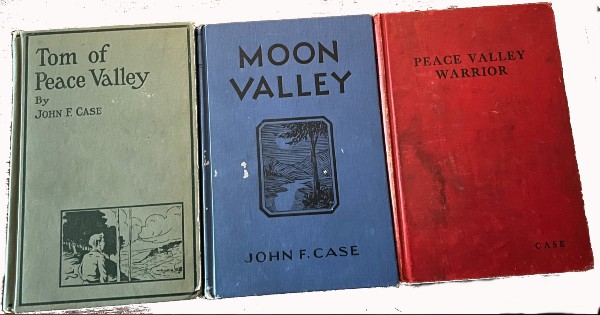
Figure 1 – The Agricultural Education Trilogy.
Tom of Peace Valley – The first book was published in 1925, three years before the start of the Future Farmers of America (FFA). The main character, Tom Woodson, left his isolated backwoods valley so that he could attend high school in the town of Blanton, 10 miles away from home. He found a place to board and started school. The school had just started a vocational agriculture program and Tom enrolled.
Tom excelled in school and was a star football player and corn judge. However, there was rivalry with Bull Durham, the son of the town banker and school board president. Tom chose corn for his farming project and was enrolled in the state corn growing contest, however someone kept trying to sabotage Tom’s project.
A past Friday Footnote focused on this book. To read the entire account of Tom of Peace Valley, please follow this link – https://footnote.wordpress.ncsu.edu/2018/11/30/tom-of-peace-valley/.
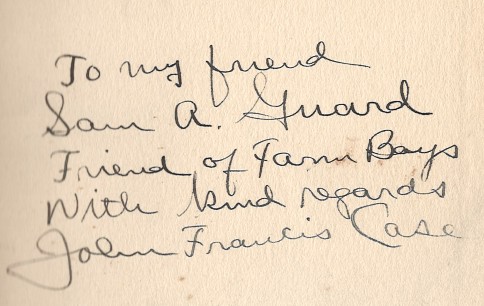
Figure 2. My copy of Tom of Peace Valley is signed by John Francis Case. It was autographed to Sam Guard who was a farm radio broadcaster in Missouri.
Moon Valley – Tom Woodson, the main character in Tom of Peace Valley, reappears – this time as the agriculture teacher at a newly created high school in his home area. He has been to college where he was an all-American football player but turned down some lucrative coaching jobs to return home to teach vocational agriculture. Even though many were elated that the local boy who had achieved fame was coming home, not everyone shared that view.
The newly created high school was the result of a voter’s referendum and resulted in the consolidation of several local schools. The beginning of a vocational agriculture program at the new school was welcomed by some progressives, but there was opposition from others who didn’t want the new tax burden and were satisfied with the status quo.
The day before school was to start someone set fire to the new school building but it was quickly extinguished. During the first few weeks of school Tom had to resort to physical altercations with unruly students in order to show them who was in charge.
To illustrate the value of vocational agriculture Tom started some night adult classes in the areas where there was the greatest opposition to the program. While some welcomed the classes others were not welcoming. When Tom went to visit some of the farmers, he was not welcome. One hired hand even decided to “thrash” the upstart teacher but instead got thrashed himself and was humiliated.
As fate would have it, Tom became enamored with a local farm girl, but the girl’s father who was opposed to the new school, forbade Tom from seeing his daughter.
As the story evolves, shots are fired at Tom, the new school was eventually burned down, and the vicious farm hand vows to get revenge on Tom but disappears. However, the voters had finally begun to realize the worth of vocational agriculture and voted to rebuild the school. Tom had finally won the support of the farmers and the students. And the girl.
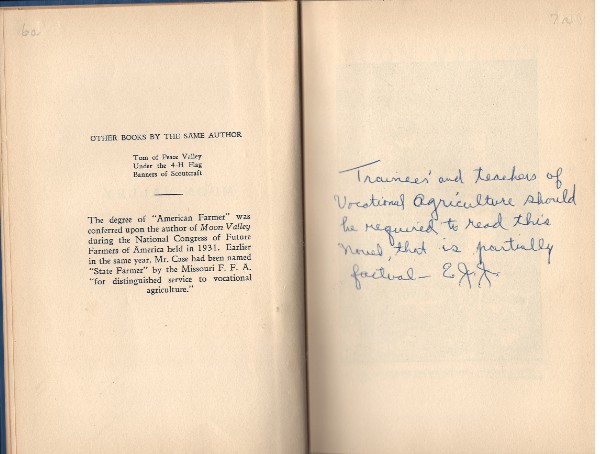
Figure 3. My copy of Moon Valley was once owned by E. J. Johnson. He was a national FFA Officer in 1936-37, taught high school agriculture in Tennessee, was a state supervisor in Colorado, and was later employed by the U.S. Office of Education with Agricultural Education and FFA responsibilities. He oversaw the archives at the National FFA Center in Alexandria. From this note in Moon Valley it appears he would encourage agriculture teachers to read Moon Valley.
Peace Valley Warrior – The first two chapters in this book revolve around legislative maneuvering at the state legislature focusing on roads. Tom Woodson, had been elected to represent his county in the state legislature and had received permission from the state and federal agricultural education officials to serve in this capacity while maintaining his vocational agriculture teaching position. He and his rural counterparts were wanting roads built in the rural part of the state while the political establishment wanted highways improved in the more populated areas of the state. Eventually Tom prevailed after much political intrigue. After the legislative session ended Tom returned to his teaching position in Peace Valley.
Upon his return to Peace Valley Tom was immediately involved in trying to solve the mystery of livestock being rustled. Who was behind the plan to butcher livestock in their pastures and haul the dressed carcasses away? It had to be someone local who knew the area. Several of his students had lost their livestock projects to these rustlers/butchers After investigating several crime sites he was able to find tire tracks and sketch them. One rear tire was bald with the other having knobby treads.
Tom then divided his students up in teams and sent them out to inspect the trucks in the area. The cover story was they were looking to purchase a truck for use in the vocational agriculture program. Even if the truck owner had no plan to sell his truck, the boys wanted to look at the truck to get ideas and determine the value of trucks in the area. It didn’t take long for one team of boys to find the truck with a bald back tire and knobby tire. This led to the arrest of the truck owner and his accomplice.
Upon investigation it was discovered the truck owner was wanted in a neighboring state for murder and there was a $5,000 reward for his capture. With the reward money Tom was able to cover the losses of the livestock for his students and farmers in the area.
In the meantime the political party boss was trying to bribe Tom to be a “team player” with offers of a high paying job – about five times the salary of being an agriculture teacher. If Tom would leave the legislature and do the bidding of the political boss, this would happen. This made Tom mad, and he decided to run again for the legislature and seek the position of speaker of the house.
The party boss then tried to get Tom fired from his job, but that didn’t work. Tom won reelection and after much political intrigue became speaker of the house. To the astonishment of the party boss, Tom appointed committee chairs based on merit, regardless of their political affiliation.
The party boss wanted to cut education spending and redirect the road budget. On the night before the pivotal vote over which Tom was to preside, the thugs employed by the political boss tried to kidnap Tom. However, Tom put up a fight and got shot in the ensuing melee and was hospitalized. Defying the doctor’s orders, Tom left the hospital the next morning to preside over the crucial house vote. When the legislators learned of what happened to Tom, even the political cronies of the party boss, voted to support Tom’s position.
Later, Tom is persuaded by various people who believe in honesty and ethics to run for governor of the state. The corrupt party boss meets with Tom and agrees to change his ways and throws his support behind Tom. Tom is elected governor.
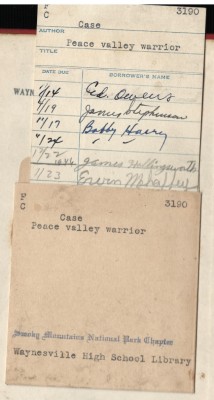
Figure 4. My copy of Peace Valley Warrior was once in the FFA library of the Smoky Mountain National Park FFA chapter in Waynesville, North Carolina. The library card shows that it was read.
Who Was John F. Case?
John Case was born September 30, 1876 on a farm in Lyon County, Minnesota. Several years later, his family moved to Grant County, South Dakota, where his father homesteaded land. In 1888, the family moved again, this time to a farm outside Whitesville in Northwestern Missouri.
Case began working as a printer’s devil for a nearby town newspaper, the Rea Times, in 1890. During the next eight years, he worked in various capacities for several Iowa newspapers: the Blockton News, the Lorimor Journal, and the Des Moines Nonpareil.
After moving back home and getting married, in 1899 he established the Whitesville Banner. For the next twelve years, he worked to build up both the newspaper and the town. He boosted the town’s corn and poultry show tirelessly. In 1913 he became editor of the Missouri Ruralist magazine.
While living in Whiteville Case sponsored a corn club for farm boys at the same time Oscar Benson, one of the founding fathers of 4-H, was beginning his work in Iowa.
In 1915, Case bought a farm near Whitesville, informing his readers that as a farm owner he would feel in just a little closer touch with the men and women who live on farms, read their helpful letters with just a little keener interest, and ask for helpful suggestions with the same spirit of neighborliness that you ask one another. In 1919, the Ruralist opened an editorial office in St. Louis and Case moved his family to Shady Lawn Farm Home, a small farm outside of Wright City, about fifty miles from St. Louis.
Arthur Capper, a U.S. Senator and ardent supporter of agriculture, owned numerous farm publications including the Missouri Ruralist. In addition to being editor of the Missouri Ruralist, Case was also in charge of the Capper pig and poultry clubs. This activity continued for 12 years and had 10,000 members enrolled. When the 4-H program became well established, the club work was dropped.
From 1921 to 1937 Case served on the University of Missouri’s Board of Visitors. He also served as president of the Missouri Corn Growers Association and the American Agricultural Editors Association. In the early days of the FFA Case helped organize and judge the FFA public speaking contest (Senator Capper was the sponsor of the FFA public speaking contests in the early days of FFA).
Case wrote two other novels, Under the 4-H Flag and Banners of Scoutcraft.
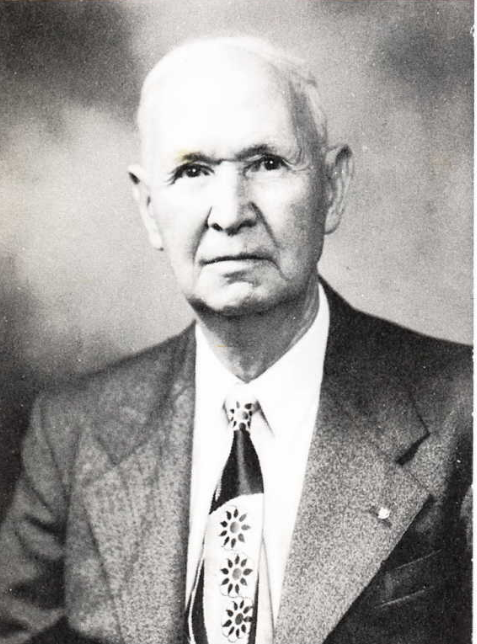
Figure 5. John Francis Case
Concluding Remarks
John F. Case was an ardent supporter of agricultural education. I found the dedication for each of the three books interesting
- Tom of Peace Valley was “Dedicated to the Farm Boys of America.”
- Moon Valley was “Dedicated to Those Builders of Citizenship, The Vocational Agriculture Instructors of America.”
- Peace Valley Warrior was “Dedicated to the Advancement of Vocational Agriculture Instruction in the Schools of America.”
As we start a new school year this might be a good time for all of us to rededicate our commitment to our students and our profession. We have an important job.
And we might also encourage our students to read more. The Ewing FFA Chapter in Lee County, Virginia had six goals for 1929. Goal number 5 was “Every member to read ‘Tom of Peace Valley’ and ‘The Brown Mouse’ during the school year” (Chapter Chats, November 1928). So, what are you going to encourage your students to read during the year?
